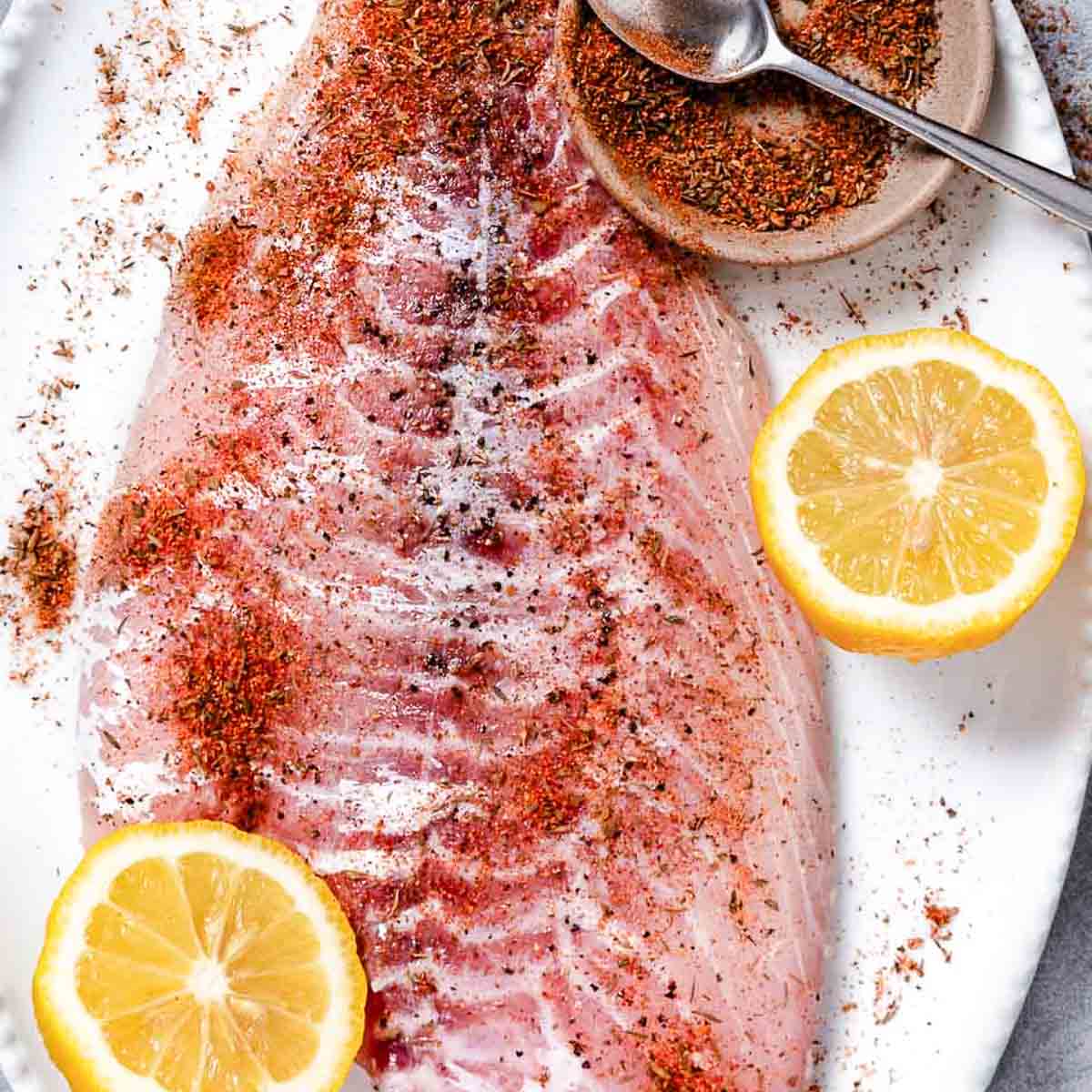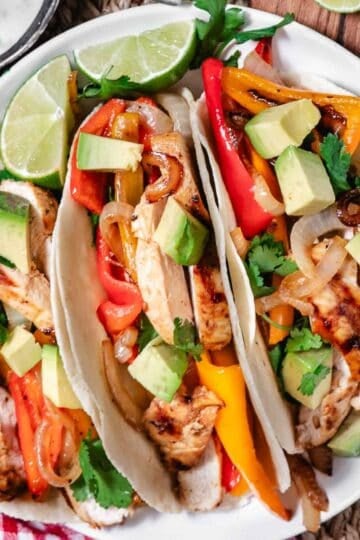Blackened fish is a favorite here in the Florida Keys. It starts with a simple spice mix and a hot cast iron skillet. This cooking style comes out of New Orleans and was made popular by Chef Paul Prudhomme. You coat the fish or shrimp with seasoning, sear it fast, and you get big, smoky flavor in just a few minutes. It’s spicy, quick, and full of great taste.

Jump to:
- What's the Difference between Cajun and Creole Cooking?
- What is Blackened Seasoning?
- Cajun Blackened Fish Seasoning Recipe
- How to Blacken Fish in a Skillet
- Blackened Swordfish
- A Brief History of Louisiana Cooking
- Seared & Blackened Yellowfin Tuna
- Blackened Baked Snapper with Key Lime Butter
- Blackened Grilled Grouper Collar
- Blackened Tripletail Recipe
- Blackened Fish Tacos
- Top Tips For Blackened Fish
- Oven Roasted Mahi Mahi
- Oven Roasted Swordfish
- Blackened Mangrove Snapper
- Fish and Grits
- Broiled Yellowtail Snapper
- Swordfish Tacos
- Blackened Fish Omelet
- Cajun Blackened Shrimp Recipe
- What Goes with Blackened Fish?
- Blackened Fish and Shrimp
- Frequently Asked Questions
These blackened seafood recipes are quick, bold, and full of Cajun flavor. Made with a simple spice blend and seared in a hot pan, you’ll have dinner on the table in under 30 minutes. Try them with snapper, mahi, swordfish, or shrimp for a perfect Florida Keys-style meal.

What's the Difference between Cajun and Creole Cooking?
Chef Paul Prudhomme explained it best:
“Cajun food is old French cooking with Louisiana products.”
Creole cooking came from the city of New Orleans, where people from many cultures settled. With seven different flags over the city, the food became a mix of French, Italian, Spanish, and others. Cooks had to adapt to each household’s tastes. Over time, they created a new style of cooking.
Cajun food comes from the countryside. It’s based on traditional French techniques, passed down for hundreds of years, using local Louisiana ingredients. A rich brown roux is one of the key elements, tied to both French and old Italian cooking.
"Louisiana Legends” from January 30, 1984, interview with Paul Prudhomme

What is Blackened Seasoning?
Blackened seasoning, also known as Cajun seasoning, was created by Chef Paul Prudhomme at his New Orleans restaurant, K-Paul’s Louisiana Kitchen.
It’s a bold mix of salt, black pepper, cayenne, paprika, thyme, and oregano. These are classic flavors from both Cajun and Creole cooking.
If you want to make your own, check out my Cajun seasoning recipe.
Cooks often use the terms Cajun and blackened seasoning interchangeably. Some say Cajun is spicier, but both blends come from the same Southern roots.
Cajun Blackened Fish Seasoning Recipe
This spice mix is easy to make at home with pantry staples. You can also find blackened seasoning near the seafood section at most grocery stores or fish markets.
How to Blacken Fish in a Skillet
- Start by mixing your seasoning: paprika, cayenne, garlic powder, onion powder, salt, black pepper, thyme, and oregano.
- Pat the fish dry with a paper towel. This helps the spices stick and keeps the fish from steaming.
- Turn on your stove fan. Things will get smoky.
- Brush each fillet or piece of shrimp with melted butter or olive oil.
- Heat 2 tablespoons of butter or oil in a heavy skillet over medium-high heat. Cast iron works best.
- Add the fish and sear until it forms a dark crust and cooks through. Thin fillets and shrimp take about 5 minutes. Thicker fish like a big red snapper or swordfish may take up to 15 minutes.
Blackened Swordfish
This recipe brings out the bold flavor of Cajun seasoning while keeping the swordfish moist and tender. It’s easy enough for a weeknight and good enough for company.
A Brief History of Louisiana Cooking
Louisiana cooking comes from two main traditions: Cajun and Creole. They share some ingredients but have different roots.
Cajun food began with the Acadians, French settlers who were forced out of Nova Scotia in the 1700s. They resettled in southwest Louisiana and adapted to the bayou.
With plenty of fish and shellfish available, they built their cooking around catfish, crawfish, shrimp, oysters, and alligator. Dishes like gumbo, étouffée, and jambalaya come from this tradition.
Creole cuisine developed in New Orleans. It was shaped by the city’s mix of cultures including French, Spanish, African, and Caribbean. As a busy port, New Orleans brought people and flavors together, creating a more worldly style of cooking.
Seared & Blackened Yellowfin Tuna
Yellowfin tuna, also called ahi, is coated in blackened seasoning and seared quick and hot. Serve it as an appetizer or main dish with rice or a green salad.
Sear the tuna for no more than 30 seconds per side. Let it rest in the fridge to firm up before slicing.
Blackened Baked Snapper with Key Lime Butter
Blackened fish is usually cooked in a hot cast-iron skillet, but you can bake it too. This easy recipe gives you tender white fish fillets topped with a simple key lime butter sauce.
Blackened Grilled Grouper Collar
Grouper collars come from just behind the head and around the clavicle. The meat is sweet, tender, and often overlooked. You won’t find them in grocery stores, but they’re a real prize if you catch your own. This recipe is simple and perfect after a long day on the water.
Blackened Tripletail Recipe
Tripletail is a local favorite with sweet, flaky meat. A hot cast-iron skillet and bold Cajun seasoning give it a dark crust and big flavor. It stays juicy and tender inside and comes together fast.
Blackened Fish Tacos
These tacos start with spicy blackened fish tucked into soft tortillas. They’re topped with sweet mango slaw and a creamy cilantro lime sauce. The heat from the fish balances perfectly with the cool, fresh toppings.
Top Tips For Blackened Fish
- Buy your fish from a good local market. Fresh makes a huge difference!
- Don’t overcook the fish. It dries out fast.
- Cooking in butter gives a darker crust but can get smoky. Make sure your kitchen has good ventilation. You can also use olive oil or a mix of butter and oil.
- Thin fillets like yellowtail, hogfish, or mango snapper need a lighter hand with the seasoning so the fish flavor still comes through.
- Like it spicy? Double the cayenne. As written, the recipe has a little kick, but it’s mild.
Oven Roasted Mahi Mahi
This easy recipe starts with fresh mahi fillets coated in seasoning and baked at 375°F for about 15 minutes. The fish stays moist with a light crust and bold flavor.
You can use Old Bay for a classic East Coast taste or go with Cajun blackened seasoning for more heat.
Oven Roasted Swordfish
Oven Roasted Swordfish is an easy, hands-off way to cook this meaty fish. Just season and roast until tender and flaky. It’s simple, delicious, and makes a great meal.
Blackened Mangrove Snapper
This Florida favorite is seasoned with blackened spice and seared in a hot pan. It’s served with a fresh mango slaw made from cabbage, ripe mango, and a touch of honey. Simple, sweet, and spicy.
Fish and Grits
Fish and Grits is a full breakfast dish originating in the Florida Keys. This filling breakfast meal has hot creamy grits, bacon, eggs, onions, and small white flaky fish fillets called grunts.
Broiled Yellowtail Snapper
Broiling yellowtail is simple and reliable. It’s a healthy way to cook fish with little or no oil. Just season with blackened spice and broil until the top browns and the fish flakes with a fork.
Swordfish Tacos
Blackened Swordfish Tacos are loaded with big flavor. Seared swordfish is layered with warm tortillas and topped with onions, cilantro and a creamy sriracha sauce. It’s a fresh, spicy meal that comes together fast. Learn how to make the leftovers into a fish omelette for breakfast tomorrow morning!
Blackened Fish Omelet
We turned oven-baked swordfish into an amazing omelet with the left overs!
Cajun Blackened Shrimp Recipe
Get a taste of real Cajun flavor with this quick blackened shrimp recipe. It’s bold, simple, and on the table in under 15 minutes.
What Goes with Blackened Fish?
Here are a few sides that pair well with bold, spicy fish:
Blackened Fish and Shrimp
These blackened seafood recipes use fresh fish and shrimp from the warm waters of the Florida Keys. They’re bold, simple, and quick to make.
Blackening means coating seafood in spices and searing it in a hot pan. Chef Paul Prudhomme made it famous at K-Paul’s in New Orleans. His blend came from Cajun and Creole cooking, rooted in French, Caribbean, Acadian, and Native American traditions.
Serve with lemon wedges and your favorite sides for a meal that’s easy to make and full of flavor.
Check out all of Healthy Seafood Recipes from more inspirations!
Frequently Asked Questions
You can blacken any fish. Use the freshest local fish you can find. In Florida, that means snapper, mahi, hogfish, grouper, snook, or flounder. Wild-caught fish is always better than farm-raised.
Blackened seafood is seasoned with a bold spice mix and seared in a hot cast-iron skillet. It gives fish or shrimp a spicy crust and juicy center.
Yes, you can use the same seasoning on chicken, beef, or pork. Searing over high heat gives the meat a flavorful crust and a little heat.
Yes. A heavy-bottomed stainless steel pan works too. Just make sure it gets hot enough to sear the fish and form a crust.
It has a little heat, but you can control it. The cayenne pepper adds spice, so use more or less depending on your taste.





















Leave a Reply
You must be logged in to post a comment.